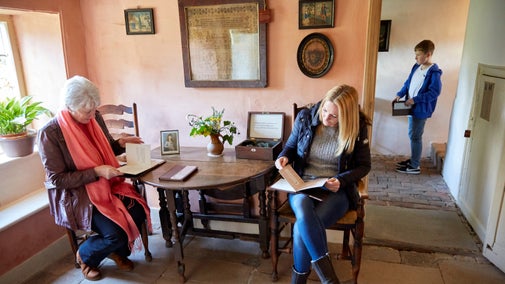
Discover more at St George's Guildhall
Find out when St George's Guildhall is open, how to get here, the things to see and do and more.

The Grade I listed Guildhall of St George is the largest surviving medieval guildhall in the country. After its beginnings as a religious meeting house it went on to establish an unrivalled history as a theatrical venue – the only theatre in the world that can claim Shakespeare himself performed there. With its construction dating back to the early 15th century, there are over 600 years of history to explore here.
The Guild of St George was a medieval religious fellowship founded in c.1376. In 1406 it acquired land reclaimed from the River Ouse to build its meeting hall, which was in use by 1428.
Following the Dissolution of the Guilds in 1547 the Guildhall became the property of Lynn Corporation, who owned it until 1814. The building served as the public ‘common hall’ as well as a courthouse, merchants’ exchange, French school, and even an armoury and gunpowder store in the 1640s.
The building’s history as a theatre stretches back to its early decades. The earliest record of a theatrical production is a nativity play before a Guild feast in 1445.
In the following years the Guild staged various theatrical events and a St George’s Day procession featuring Guild members’ children, a dragon and a castle on wheels, which took place every year until 1546. After the Dissolution it was used by companies of ‘players’ (actors); the Queen’s Players were here seven times between 1585 and 1595.
Recent academic research supports the local tradition that Shakespeare himself played here with the Earl of Pembroke’s Men in 1593, when London theatres were closed by plague. Shakespeare’s leading comic actor, Robert Armin, who is credited with being a major influence on the playwright, was born in King’s Lynn in 1565, and lived in what is now 78 High Street.
In the 17th century players continued to use the Guildhall until the Commonwealth banned such performances. After the Restoration in 1660 various Norwich theatre companies leased it during the annual February Mart (marketplace festival) season and continued to do so through to the 18th century.
By 1766, drama at the Guildhall was so successful that the mayor commissioned a playhouse to be built inside it for £450. In 1769 Thomas Snagg, Britain’s leading comic actor, described the town as ‘a good one for comedians’ with a ‘very pretty’ theatre, while the then editor of the Cambridge Chronicle noted the problem of rowdy audiences, due to ‘irregular persons mixing with their superiors’.
The success of the playhouse led to the Theatre Royal being built in St James’s Street in 1813, and the Guildhall was sold in 1814 to William Lee Warner for £557.
His estate was bought by the neighbouring Lynn merchant family of Everard in 1826 and the Guildhall became a warehouse. The Everards then sold it for £2,650 in 1920 to internationally renowned scenic artists G.M. Bridges and Son Ltd., who were already the tenants.
The impact of cinema took away much of the firm’s work and by 1945 the Guildhall was not only derelict but in danger of being demolished. To prevent its demolition it was purchased by local landowner Alexander Penrose.
Penrose proved to be the Guildhall’s saviour and before his death in 1950 he led a project to convert it into an arts centre, with funding from the Arts Council, Pilgrim Trust and public subscription.
The centre was opened by Queen Elizabeth, the Queen Mother, for the first King’s Lynn Festival in July 1951. The same year the building was given to the National Trust.
Today the Guildhall is leased by King's Lynn and West Norfolk Borough Council for hire by the public as a space for performances, lectures and entertainment. We have been working with the Council, as they progress their plans to secure the funding required to deliver a sustainable future for the Guildhall site. You can find out more here.
The various groups involved with the use of the building include King's Lynn Festival and Shakespeare's Guildhall Trust, who work closely with the National Trust to preserve the site’s unique theatrical heritage.

Find out when St George's Guildhall is open, how to get here, the things to see and do and more.
Learn about people from the past, discover remarkable works of art and brush up on your knowledge of architecture and gardens.

Visit the vibrant 200-year-old theatre with a year-round programme of entertainment to suit all tastes.

Walk in the footsteps of famous faces. From The Beatles and Sir Winston Churchill, to Agatha Christie and Isaac Newton, step into their former homes and learn more about their lives.

From the medieval Guildhall of Corpus Christi to the winding, hidden lanes and historic architecture, there's plenty to discover on a visit to Lavenham village.
